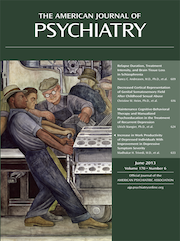Cognitive Experiences Reported by Patients With Borderline Personality Disorder and Axis II Comparison Subjects: A 16-Year Prospective Follow-Up Study
Abstract
Objective
The authors assessed three main types of disturbed cognition: nonpsychotic thought (odd thinking, unusual perceptual experiences, and nondelusional paranoia), quasi-psychotic thought, and true psychotic thought in patients with borderline personality disorder followed prospectively for 16 years. They also compared the rates of these disturbed cognitions with those reported by axis II comparison subjects.
Method
The cognitive experiences of 362 inpatients (290 borderline patients and 72 axis II comparison subjects) were assessed at study entry using the cognitive section of the Revised Diagnostic Interview for Borderlines. Participants’ cognitive experiences were reassessed every 2 years using the same interview.
Results
Each of the five main types of thought studied was reported by a significantly higher percentage of patients in the borderline group than in the axis II comparison group over time. Each of these types of thought, except true psychotic thought, declined significantly over time for participants in both groups. Eleven of the 17 more specific forms of thought studied were also reported by a significantly higher percentage of patients in the borderline group over the follow-up period: magical thinking, overvalued ideas, recurrent illusions, depersonalization, derealization, undue suspiciousness, ideas of reference, other paranoid ideation, quasi-psychotic delusions, quasi-psychotic hallucinations, and true psychotic hallucinations. Fourteen specific forms of thought were found to decline significantly over time for participants in both groups: all forms of thought mentioned above except true psychotic hallucinations plus marked superstitiousness, sixth sense, telepathy, and clairvoyance.
Conclusions
Disturbed cognitions are common in patients with borderline personality disorder and are distinguishing for the disorder. They also decline substantially over time but remain a problem, particularly those of a nonpsychotic nature.



